In-Situ Synthesis of Multiscale Al2O3 and AlSi3Ti2 Reinforced Al Matrix Composites Based on Al12Si-TiO2 System
Abstract
1. Introduction
2. Experimental
2.1. Materials
2.2. Composite Fabrication
2.3. Materials Characterization
3. Results and Discussion
3.1. Structure Characterization of Composites
3.2. Mechanical Properties and Fracture Behavior of Composites
4. Conclusions
Author Contributions
Funding
Data Availability Statement
Conflicts of Interest
References
- Samal, P.; Vundavilli, P.R.; Meher, A.; Mahapatra, M.M. Recent progress in aluminum metal matrix composites: A review on processing, mechanical and wear properties. J. Manuf. Process. 2020, 59, 131–152. [Google Scholar] [CrossRef]
- Kumar, A.; Singh, V.P.; Singh, R.C.; Chaudhary, R.; Kumar, D.; Mourad, A.-H.I. A review of aluminum metal matrix composites: Fabrication route, reinforcements, microstructural, mechanical, and corrosion properties. J. Mater. Sci. 2024, 59, 2644–2711. [Google Scholar] [CrossRef]
- Lu, Y.; Zhang, X.; Fan, X.; Shao, C.; Han, S.; Liu, Z.; Zhang, Z.; Zhang, Z. Design and fabrication of a super strong aluminum matrix composite with continuous titanium-based reinforcements. Compos. Commun. 2024, 45, 101816. [Google Scholar] [CrossRef]
- Zan, Y.N.; Zhou, Y.T.; Liu, Z.Y.; Ma, G.N.; Wang, D.; Wang, Q.Z.; Wang, W.G.; Xiao, B.L.; Ma, Z.Y. Enhancing strength and ductility synergy through heterogeneous structure design in nanoscale Al2O3 particulate reinforced Al composites. Mater. Des. 2019, 166, 107629. [Google Scholar] [CrossRef]
- Sivashanmugam, N.; Harikrishna, K.L. Effect of SiC addition in fabrication of Al/SiC metal matrix composite by stir casting. Mater. Today Proc. 2024, in press. [Google Scholar] [CrossRef]
- Liu, Z.; Luo, Z.; Zhang, X.; Yang, J.; Feng, Y.; Peng, W. Study on the microstructure, recrystallization, and mechanical properties of hot-press sintered (TiC + B4C)/6061Al composites during hot rolling. Mater. Charact. 2024, 216, 114286. [Google Scholar] [CrossRef]
- Zhao, P.; Kai, X.; Liu, S.; Huang, L.; Guan, C.; Qian, W.; Zhao, Y. Investigation on microstructure and high-temperature tensile properties of in-situ (ZrB2+Al2O3)/AA6016 nanocomposite. J. Alloys Compd. 2025, 1014, 178771. [Google Scholar] [CrossRef]
- Chen, Q.; Geng, H.; Zhang, H.; Li, X.; Chen, G. Microstructure and mechanical properties of in situ TiB2·TiAl3/2024Al composite subjected to multidirectional forging. J. Mater. Res. Technol. 2022, 21, 2827–2840. [Google Scholar] [CrossRef]
- Gao, T.; Bian, Y.; Li, Z.; Xu, Q.; Yang, H.; Zhao, K.; Liu, X. Synthesis of a (ZrAl3+AlN)/Al composite and the influence of particles content and element Cu on the microstructure and mechanical properties. J. Alloys Compd. 2019, 791, 730–738. [Google Scholar] [CrossRef]
- Xiong, H.-P.; Mao, W.; Xie, Y.-H.; Ma, W.-L.; Chen, Y.-F.; Li, X.-H.; Li, J.-P.; Cheng, Y.-Y. Liquid-phase siliconizing by Al–Si alloys at the surface of a TiAl-based alloy and improvement in oxidation resistance. Acta Mater. 2004, 52, 2605–2620. [Google Scholar] [CrossRef]
- Ma, S.; Li, N.; Zhang, C.; Wang, X. Evolution of intermetallic phases in an Al–Si–Ti alloy during solution treatment. J. Alloys Compd. 2020, 831, 154872. [Google Scholar] [CrossRef]
- Dezellus, O.; Gardiola, B.; Andrieux, J.; Lomello-Tafin, M.; Viala, J.C. On the Liquid/Solid Phase Equilibria in the Al-Rich Corner of the Al-Si-Ti Ternary System. J. Phase Equilibria Diffus. 2014, 35, 137–145. [Google Scholar] [CrossRef]
- Gao, T.; Li, P.; Li, Y.; Liu, X. Influence of Si and Ti contents on the microstructure, microhardness and performance of TiAlSi intermetallics in Al–Si–Ti alloys. J. Alloys Compd. 2011, 509, 8013–8017. [Google Scholar] [CrossRef]
- Imran, M.; Khan, A.R.A. Characterization of Al-7075 metal matrix composites: A review. J. Mater. Res. Technol. 2019, 8, 3347–3356. [Google Scholar] [CrossRef]
- Wang, J.; Zhang, X.; Zhao, N.; He, C. In situ synthesis of copper-modified graphene-reinforced aluminum nanocomposites with balanced strength and ductility. J. Mater. Sci. 2019, 54, 5498–5512. [Google Scholar] [CrossRef]
- Yi, L.-F.; Noguchi, K.; Wang, Z.; Oboso, P.B.; Chen, Z.-C. In-situ synthesis of a novel multiphase reinforced Al-matrix composite prepared from A6061 alloy and a small amount of MXene. Vacuum 2025, 234, 114133. [Google Scholar] [CrossRef]
- Zhu, J.; Luo, X.; Wang, H.; Hu, R.; Yi, X.; Chen, Y.; Ran, G. High cycle fatigue fracture mechanism of in-situ TiB2/7050Al matrix composite. J. Mater. Res. Technol. 2025, 35, 4071–4085. [Google Scholar] [CrossRef]
- Hu, J.; Gao, T.; Liu, G.; Liu, J.; Xu, W.; Liu, X. An Al matrix composite reinforced with carbon nanotubes, Al3BC, and γ-Al2O3: Investigation of mechanical, thermal, and wear resistance properties. Mater. Charact. 2025, 222, 114854. [Google Scholar] [CrossRef]
- Bian, Y.; Gao, T.; Li, Z.; Sun, Q.; Ma, X.; Liu, X. In-situ synthesis of an Al composite reinforced with multi-scale Al12Mo, (Al, Zr, Si) and Al2O3 particles through a multi-stage reaction. Mater. Sci. Eng. A 2019, 762, 138069. [Google Scholar] [CrossRef]
- Chao, Z.L.; Zhang, L.C.; Jiang, L.T.; Qiao, J.; Xu, Z.G.; Chi, H.T.; Wu, G.H. Design, microstructure and high temperature properties of in-situ Al3Ti and nano-Al2O3 reinforced 2024Al matrix composites from Al-TiO2 system. J. Alloys Compd. 2019, 775, 290–297. [Google Scholar] [CrossRef]
- Jung, C.; Nam, S.; Son, H.; Han, J.; Jeong, J.; Sung, H.; Kim, H.S.; Sohn, S.S.; Choi, H. Simultaneous enhancement of strength and ductility of Al matrix composites enabled by submicron-sized high-entropy alloy phases. J. Mater. Res. Technol. 2024, 33, 1470–1478. [Google Scholar] [CrossRef]
- Bulanova, M.; Tretyachenko, L.; Golovkova, M.; Meleshevich, K. Phase equilibria in the α-Ti-Al-Si region of the Ti-Si-Al system. J. Phase Equilibria Diffus. 2004, 25, 209–229. [Google Scholar] [CrossRef]
- Li, P.; Luo, G.; Zhang, X.; Sun, Y.; Shen, Q. The synergistic effects of heterogeneous structures enhance the strength-ductility of Al-Cu composites. J. Mater. Res. Technol. 2024, 33, 7284–7292. [Google Scholar] [CrossRef]
- Rong, X.; Zhao, D.; Chen, X.; Zhang, X.; Wan, D.; Shi, C.; He, C.; Zhao, N. Towards the work hardening and strain delocalization achieved via in-situ intragranular reinforcement in Al-CuO composite. Acta Mater. 2023, 256, 119110. [Google Scholar] [CrossRef]
- Balog, M.; Krizik, P.; Bajana, O.; Hu, T.; Yang, H.; Schoenung, J.M.; Lavernia, E.J. Influence of grain boundaries with dispersed nanoscale Al2O3 particles on the strength of Al for a wide range of homologous temperatures. J. Alloys Compd. 2019, 772, 472–481. [Google Scholar] [CrossRef]
- Jia, L.; Rong, X.; Zhao, D.; Zhang, X.; He, C.; Zhao, N. Microstructural characteristic and mechanical properties of the in-situ MgAl2O4 reinforced Al matrix composite based on Al-Mg-ZnO system. J. Alloys Compd. 2022, 891, 161991. [Google Scholar] [CrossRef]
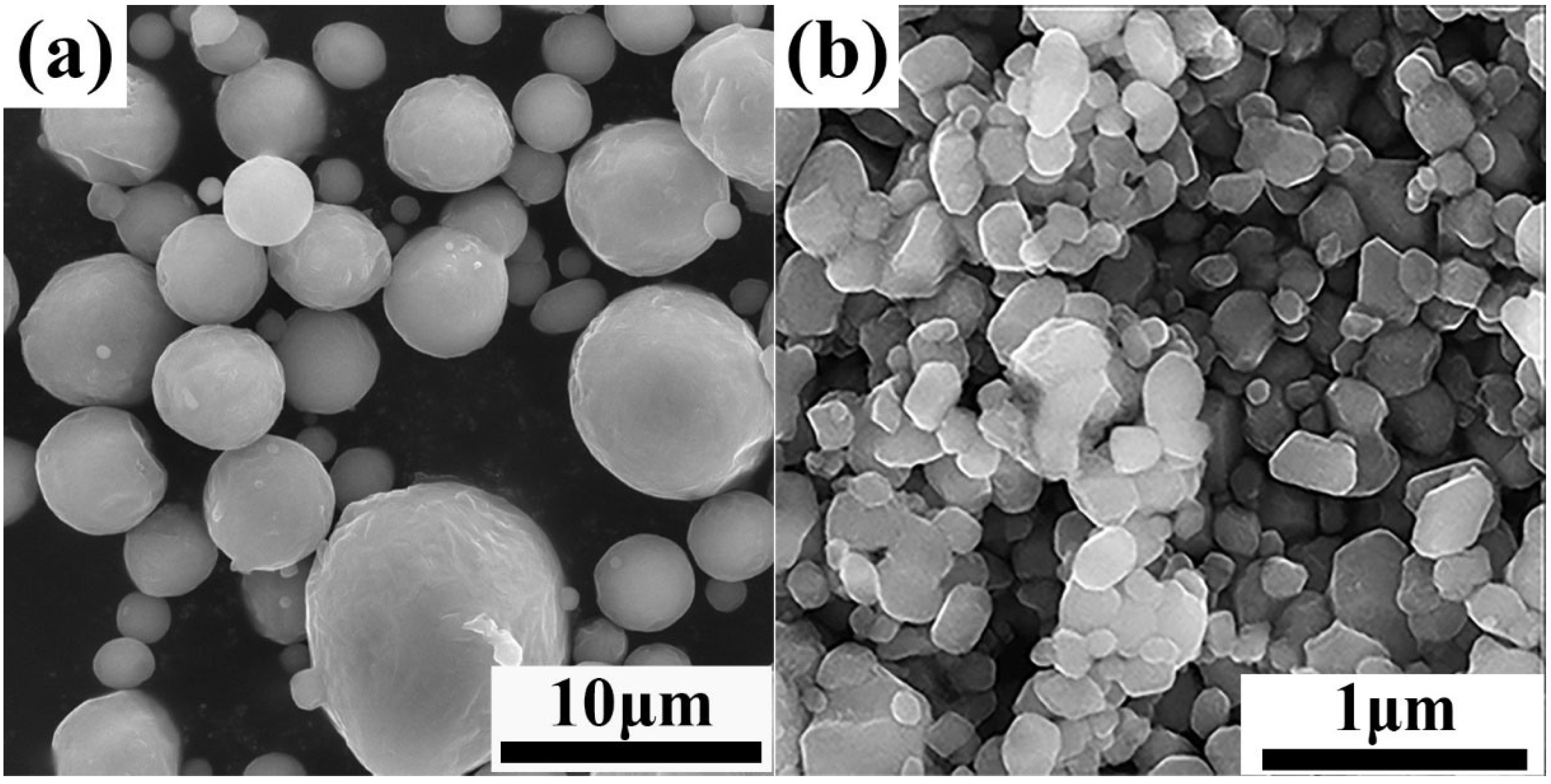
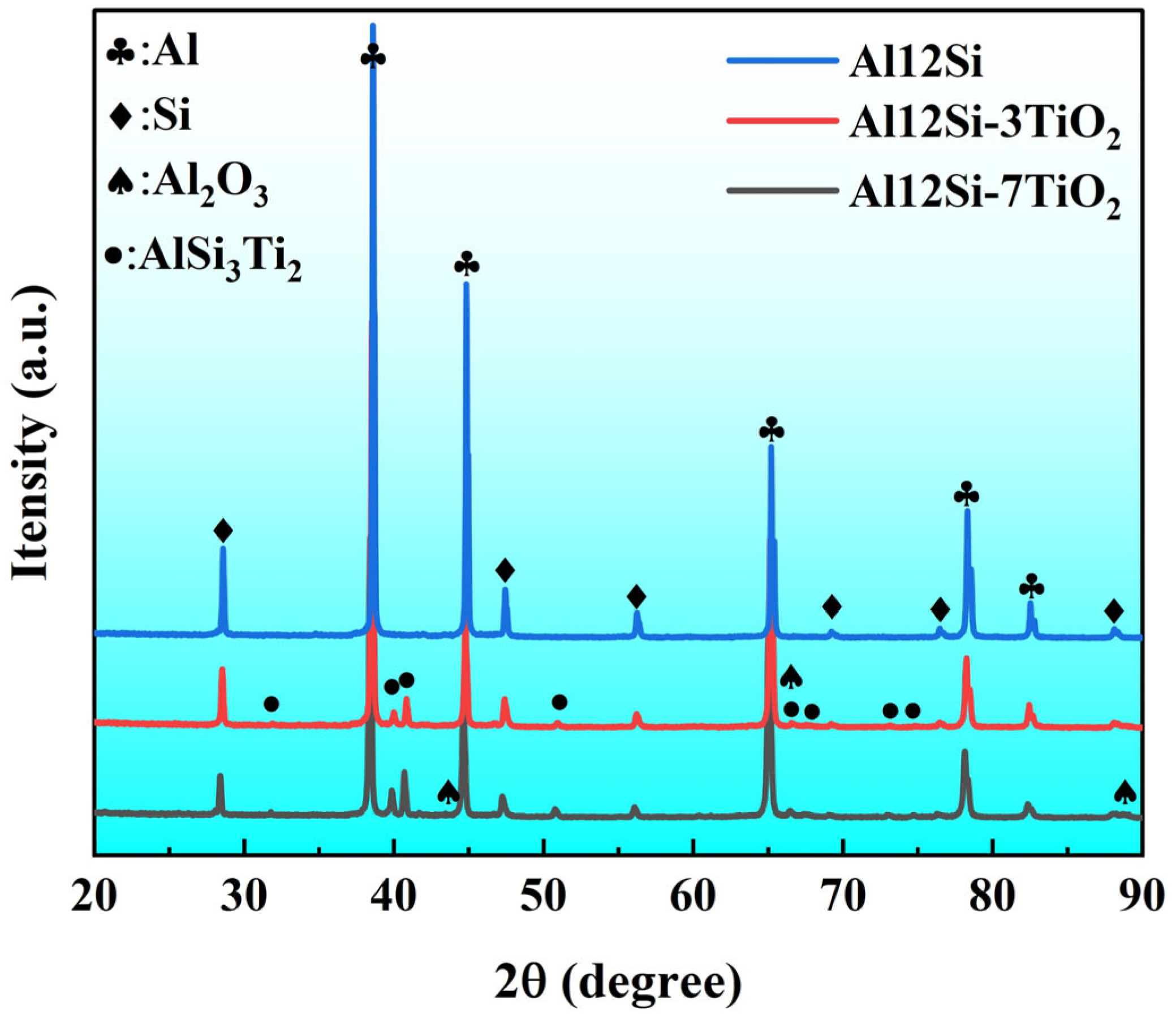

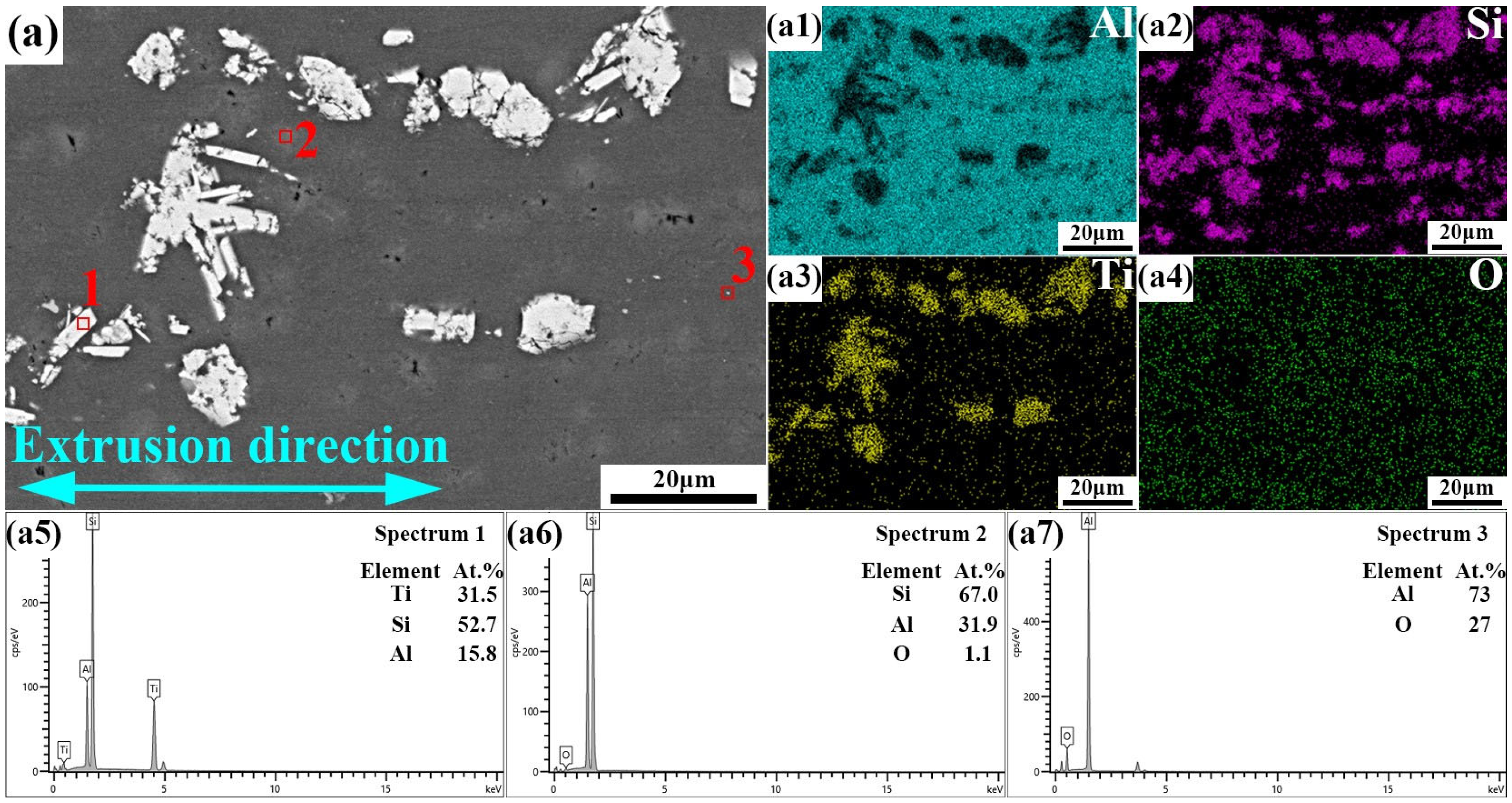
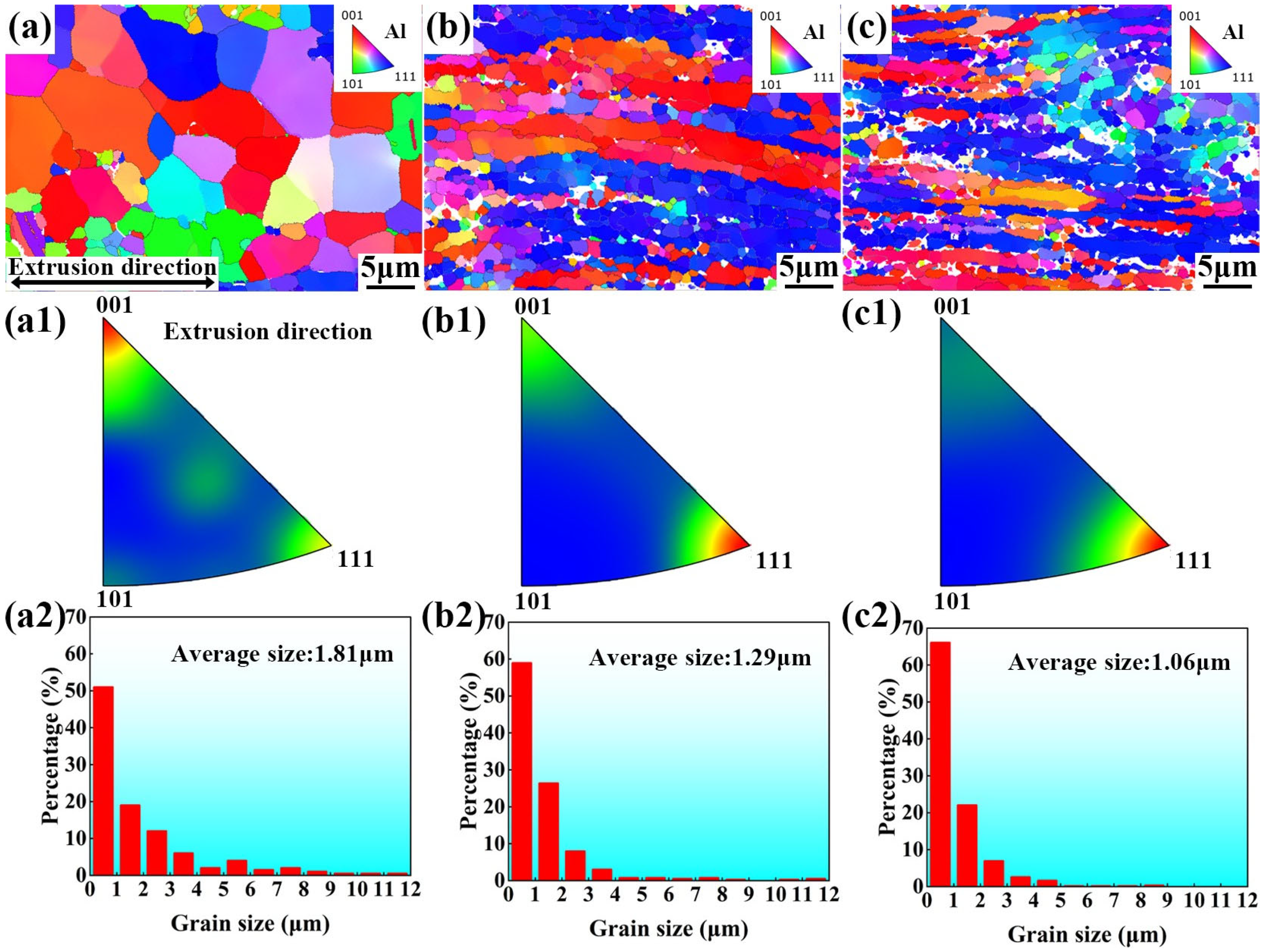
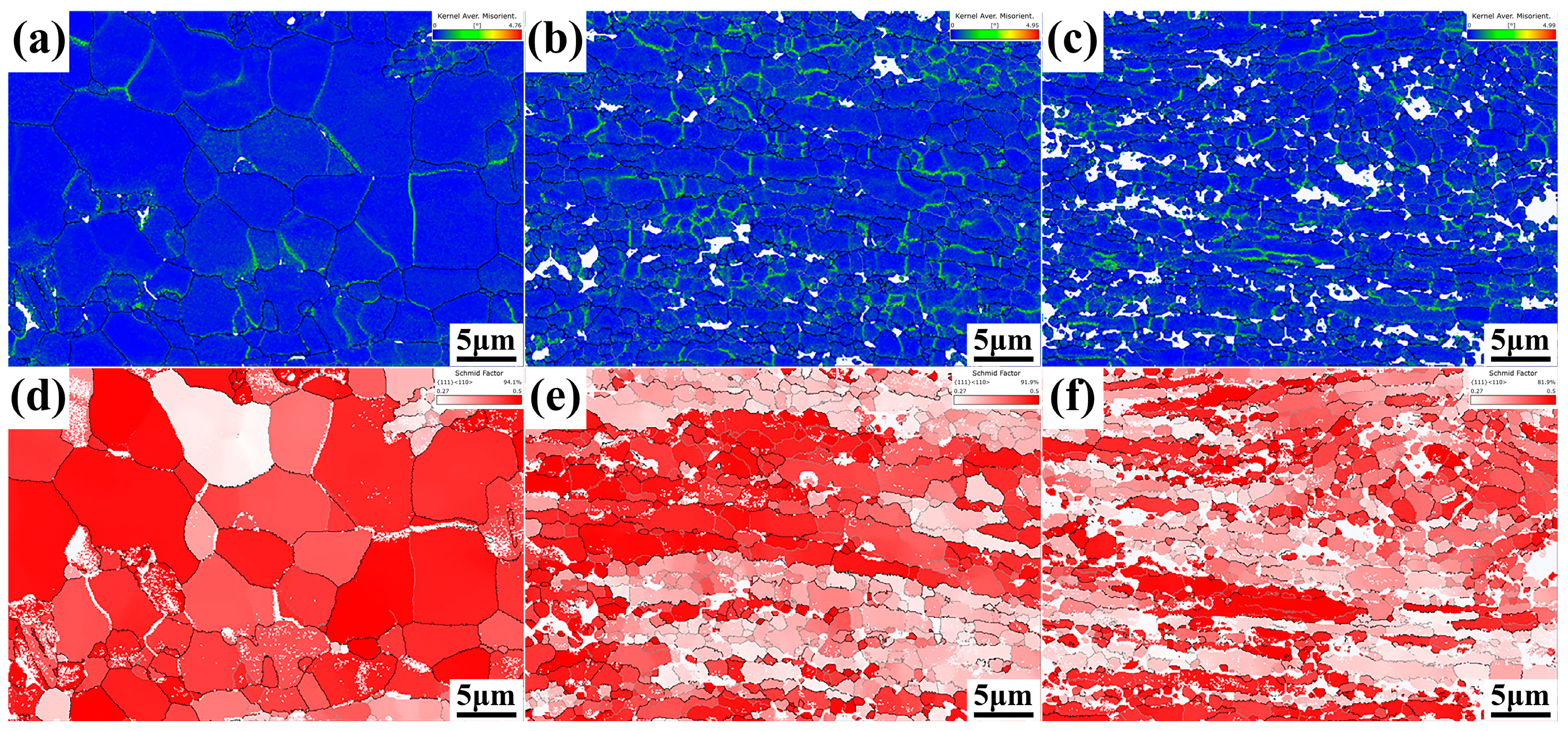


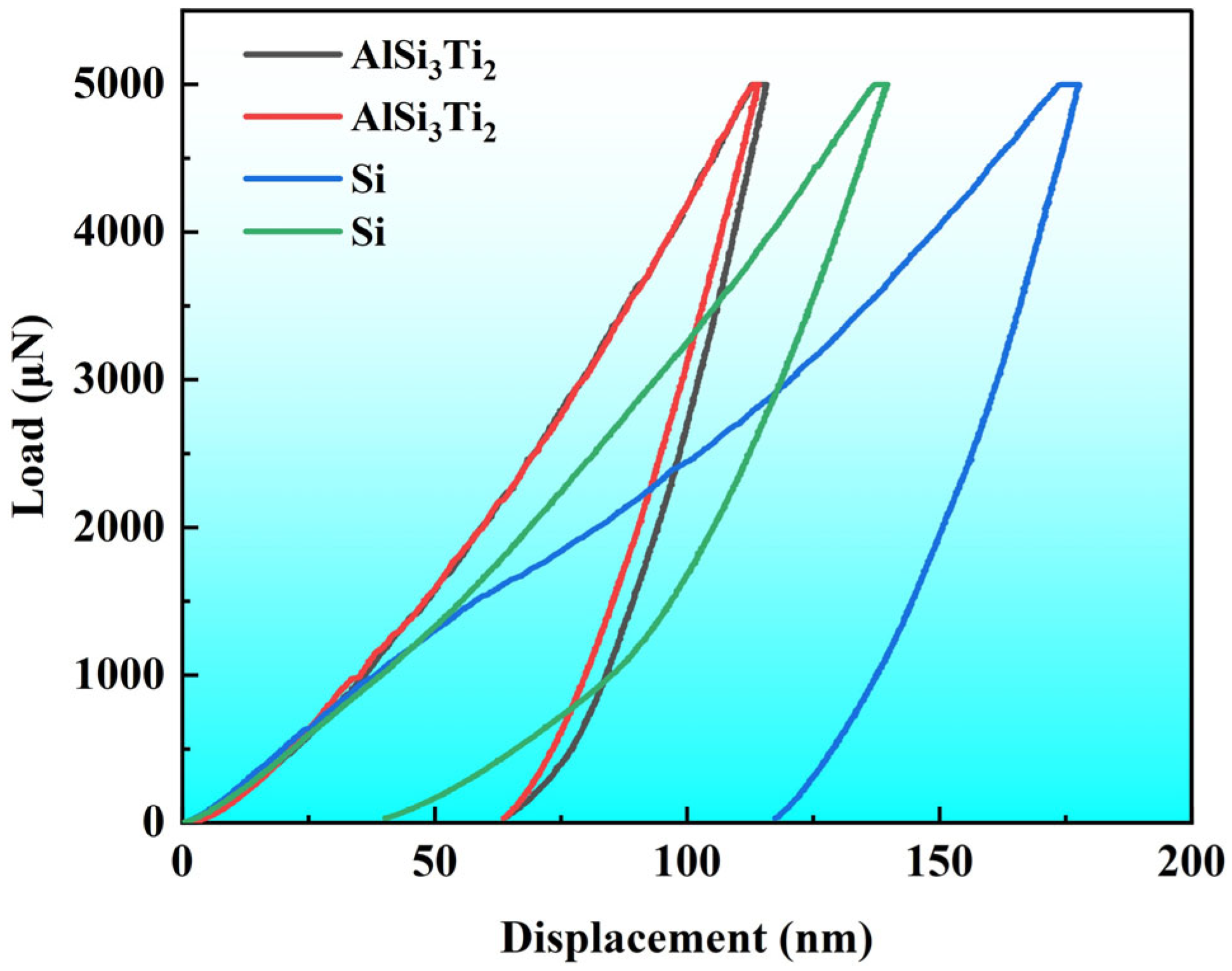
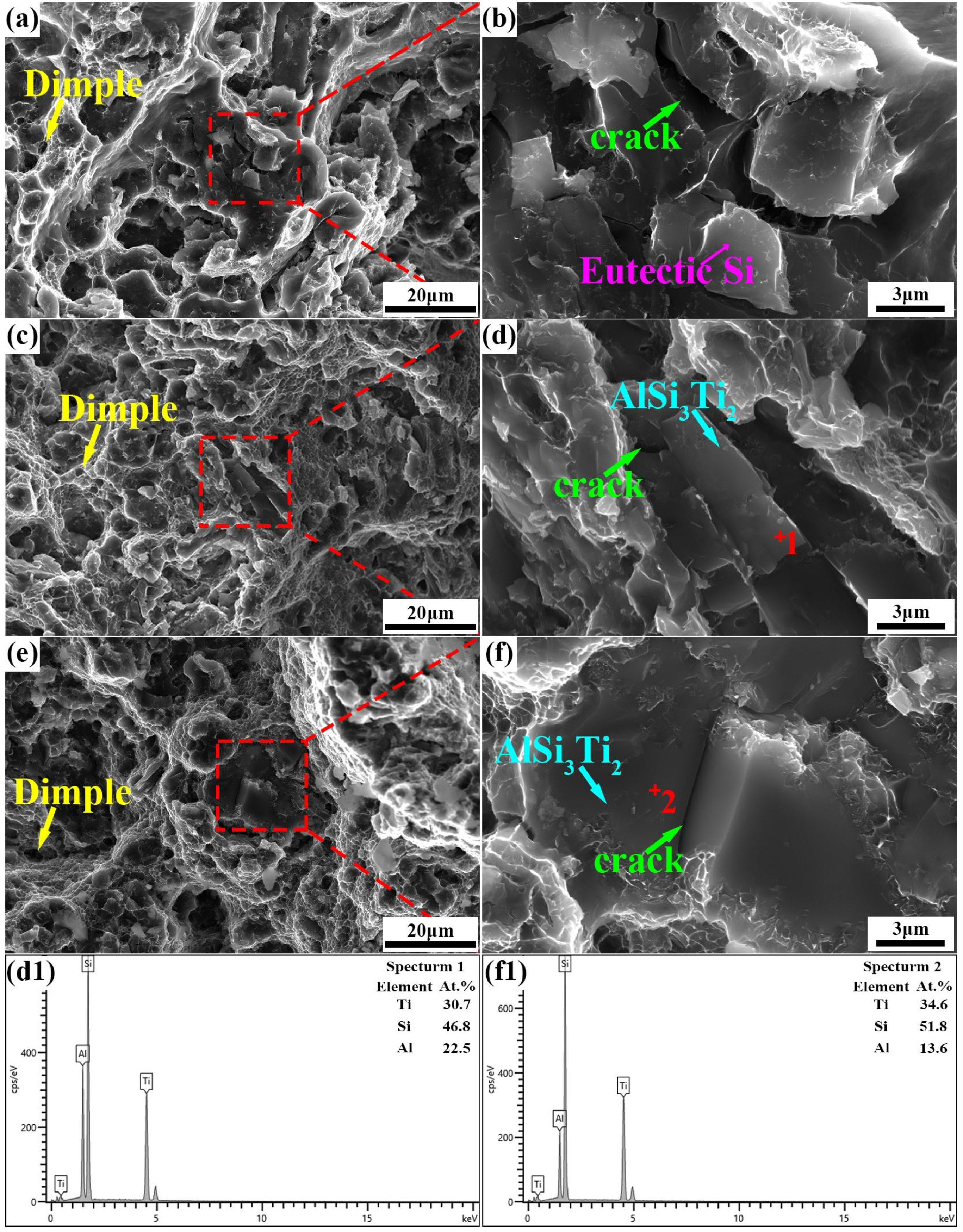
| Phase | Nano-Hardness (GPa) | Young’s Modulus (GPa) |
|---|---|---|
| Si | 127.8 ± 4.4 | 7.1 ± 2.0 |
| AlSi3Ti2 | 207.5 ± 10.9 | 11.4 ± 0.5 |
Disclaimer/Publisher’s Note: The statements, opinions and data contained in all publications are solely those of the individual author(s) and contributor(s) and not of MDPI and/or the editor(s). MDPI and/or the editor(s) disclaim responsibility for any injury to people or property resulting from any ideas, methods, instructions or products referred to in the content. |
© 2025 by the authors. Licensee MDPI, Basel, Switzerland. This article is an open access article distributed under the terms and conditions of the Creative Commons Attribution (CC BY) license (https://creativecommons.org/licenses/by/4.0/).
Share and Cite
Yao, P.; Gao, P.; Xu, Z.; Deng, X.; Li, C. In-Situ Synthesis of Multiscale Al2O3 and AlSi3Ti2 Reinforced Al Matrix Composites Based on Al12Si-TiO2 System. Metals 2025, 15, 401. https://doi.org/10.3390/met15040401
Yao P, Gao P, Xu Z, Deng X, Li C. In-Situ Synthesis of Multiscale Al2O3 and AlSi3Ti2 Reinforced Al Matrix Composites Based on Al12Si-TiO2 System. Metals. 2025; 15(4):401. https://doi.org/10.3390/met15040401
Chicago/Turabian StyleYao, Pengcheng, Peng Gao, Zunyan Xu, Xianxian Deng, and Caiju Li. 2025. "In-Situ Synthesis of Multiscale Al2O3 and AlSi3Ti2 Reinforced Al Matrix Composites Based on Al12Si-TiO2 System" Metals 15, no. 4: 401. https://doi.org/10.3390/met15040401
APA StyleYao, P., Gao, P., Xu, Z., Deng, X., & Li, C. (2025). In-Situ Synthesis of Multiscale Al2O3 and AlSi3Ti2 Reinforced Al Matrix Composites Based on Al12Si-TiO2 System. Metals, 15(4), 401. https://doi.org/10.3390/met15040401






